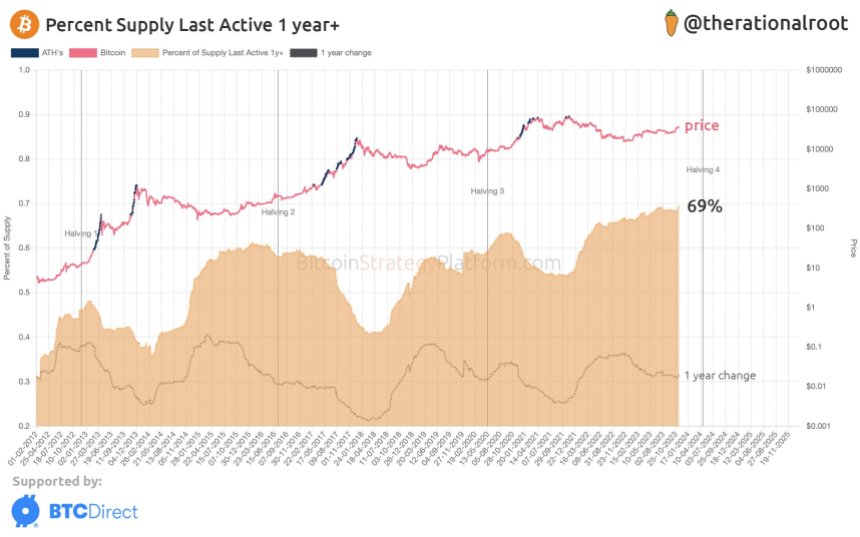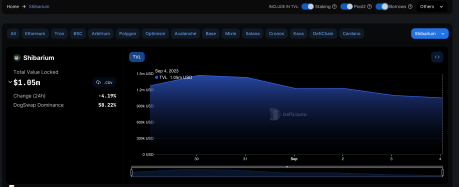 The latest bitcoin derivatives data indicates a continued climb in bitcoin futures open interest, hitting all-time peaks. Over the last day, statistics reveal an open interest of $32.30 billion across fourteen distinct bitcoin futures markets. Soaring Open Interest in BTC Futures Signals Growing Derivatives Market Friday, March 8, 2024, marked a notable day when BTC […]
The latest bitcoin derivatives data indicates a continued climb in bitcoin futures open interest, hitting all-time peaks. Over the last day, statistics reveal an open interest of $32.30 billion across fourteen distinct bitcoin futures markets. Soaring Open Interest in BTC Futures Signals Growing Derivatives Market Friday, March 8, 2024, marked a notable day when BTC […]
Source link
grows
MicroStrategy Grows Bitcoin Reserves By 14K BTC Ahead Of ETF Approval
MicroStrategy (MSTR), a prominent Bitcoin holding company, has once again expanded its BTC holdings with a substantial purchase of 14,620 Bitcoin, amounting to a staggering $615.7 million.
The former CEO of the American business intelligence (BI) firm announced the acquisition, highlighting the company’s continued confidence in Bitcoin’s long-term potential.
With the potential approval of Bitcoin spot exchange-traded funds (ETFs) on the horizon, MicroStrategy aims to capitalize on the positive impact on BTC’s price and the company’s profitability in the leading cryptocurrency market.
MicroStrategy Stock Skyrockets 337%
According to a CNBC report, MicroStrategy’s stock has experienced a remarkable 337% surge in 2023, making it one of the top gainers among US companies valued at $5 billion or more.
This success surpasses the rallies of industry giants like Nvidia and Meta. Unlike its tech peers, MicroStrategy’s appeal to investors stems primarily from its Bitcoin holdings.
MicroStrategy’s market capitalization currently stands at $8.5 billion, with a staggering 90% directly tied to its Bitcoin holdings. The company’s stock price closely mirrors the performance of Bitcoin, with significant fluctuations in response to the cryptocurrency’s price movements.
Per the report, in 2022, when Bitcoin experienced a 64% decline, MicroStrategy’s stock plummeted by 74%. Despite the substantial gains achieved this year, MicroStrategy shares are still below their peak levels in 2021, during the cryptocurrency’s peak.
Michael Saylor’s Vision
MicroStrategy’s decision to invest in Bitcoin dates back to July 2020, when the company recognized the potential of alternative assets, including digital currencies.
At that time, MicroStrategy had a market capitalization of around $1.1 billion, primarily driven by its software business, which has been shrinking since 2015. Co-founder Michael Saylor, who was CEO then, saw an opportunity to put the company’s idle cash reserves to work, considering low interest rates and the need for diversification.
Saylor’s conviction in Bitcoin as a digital form of gold led MicroStrategy to prioritize Bitcoin purchases over equities and precious metals. This strategic move exposed investors to Bitcoin indirectly through MicroStrategy’s stock.
Saylor, who transitioned to executive chairman, remains optimistic about Bitcoin’s future, expecting the bull market to continue into the next year. Despite its growing popularity, Saylor emphasized that Bitcoin still represents only a fraction of global capital allocation, with ample room for further growth.
As of December 27, 2023, MicroStrategy’s latest purchase adds to its already impressive Bitcoin portfolio, bringing the total holdings to 189,150 BTC.
The company has invested approximately $5.9 billion, with an average purchase price of $31,168 per Bitcoin. These strategic acquisitions position MicroStrategy as a major player in the crypto space, aligning its interests with the anticipated growth and adoption of Bitcoin.
The current market data shows that Bitcoin is trading at $42,900, reflecting a marginal 0.5% increase over the past 24 hours. The cryptocurrency briefly dipped below its critical support level of $42,000 but has since regained its position.
The market is anticipating the potential approval of the Bitcoin Spot ETF applications between January 5 and 10, 2024.
This development holds significant promise for Bitcoin, as it could drive the cryptocurrency’s price well beyond $50,000, establishing a new yearly high and edging closer to its historical peak.
Featured image from Shutterstock, chart from TradingView.com
Disclaimer: The article is provided for educational purposes only. It does not represent the opinions of NewsBTC on whether to buy, sell or hold any investments and naturally investing carries risks. You are advised to conduct your own research before making any investment decisions. Use information provided on this website entirely at your own risk.
Cathie Wood’s ARK Invest cashes out part of its Grayscale’s GBTC stake as Bitcoin ETF optimism grows

Cathie Wood’s asset management firm ARK Invest sold more than 700,000 shares of its Grayscale Bitcoin Trust (GBTC) holding in the past month amid the rapid closure of the fund’s discount.
Data from Cathies Ark, a website monitoring the daily trades of ARK, showed that the firm’s Next Generation Internet ETF (ARKW) offloaded 724,043 units of GBTC shares between Oct. 23 and today, Nov. 24. The firm is estimated to have earned more than $10 million from these sales.
During this period, GBTC shares value grew by more than 16% to as high as $30.85 today, Nov. 24, according to Tradingview data. This was fueled by the market optimism surrounding the possibility of the U.S. Securities and Exchange Commission (SEC) approving a spot Bitcoin (BTC) exchange-traded fund (ETF).
Grayscale is one of the numerous asset managers, including BlackRock, who have a pending application with the financial regulator.
Despite these rapid selling activities, GBTC remains one of ARKW’s largest holdings, representing more than 9% of its portfolio, behind only crypto exchange Coinbase and advertising technology firm Roku.
GBTC discount falls under 10%
GBTC’s discount to net asset value (NAV) has fallen under 10% for the first time in the last two years, according to Coinglass data.
GBTC is one of the largest BTC investment options globally, holding over 620,000 BTC valued at over $23 billion. It offers investors exposure to the top crypto asset without direct ownership.
In 2021, a discount arose due to shareholders being unable to redeem their shares. This discount expanded to nearly 50% in 2022 before narrowing to about 40% earlier this year.
However, the situation changed notably after BlackRock submitted an application for a spot BTC ETF in June, sparking heightened institutional interest in the market.
Since then, the discount has significantly decreased. Market observers have suggested that the metric serves as a real-time gauge of investors’ confidence regarding the likelihood of the SEC approving a spot BTC ETF in the U.S.
Despite a larger portion of Bitcoin’s total supply being “inactive” for over a year, recent data revealed impressive growth in investors holding on to their BTCs during the rally.
Bitcoin HODLing Yawns For Growth With Lesser Supply
On Wednesday, November 15, a crypto analyst known as Root took to his official X (formerly Twitter) handle to share valuable data concerning Bitcoin. A yearly BTC supply chart also accompanied the analyst’s X post.
According to the analyst, a significant part of BTC’s total supply has been inactive for over a year. In addition, the inactive supply has recently reached an all-time high (ATH) of 69%. The analyst stated:
69%, an all-time high, of the #Bitcoin supply, hasn’t been active for over a year. Root stated.
This supply for one year or more is only a portion of a bigger group known as long-term holders (LTHs). One of the two major groups of Bitcoin investors comprises these LTHs, while the other is known as short-term holders (STHs).
Investors holding coins longer than five to six months are classified as long-term holders. Meanwhile, those who hold coins no more than this given time are classified as short-time holders.
In addition, even among LTHs, those who have passed the one-year mark would be considered “reliable gems.” However, this variety currently comprises the majority of the asset’s supply. This seems to have also increased significantly lately, as the graph indicates.

According to statistics, holders are less likely to switch their coins any time the longer they are kept inactive. Due to this, the LTHs tend to be the most devoted segment of the market during periods of Bitcoin’s upsides or downsides.
Double Top Pattern Resurfaces Driving The Crypto To A Downward Trend
BTC has recently formed a double top pattern close to the $38,000 level, causing the token’s drop. The price has since fallen below the 100 hourly Simple moving average and the $36,500 mark.
However, it seems the bulls emerged at the $36,500 mark, giving the token momentum to sustain between $36,000 and $36,500. Following the formation of a low at $36,517, the price is currently correcting losses.
So far, there are no claims that the increase in Bitcoin HODLing has imparted the price growth of BTC. Nonetheless, this recent development sparks potential for the crypto asset over time if this continues.
Currently, the price of BTC is at $36,422 as of the time of writing, indicating a 2.94% decline over the past 24 hours. The asset’s 24-hour trading volume has also experienced an 8% drop, valued at $26,113,638,790, according to CoinMarketCap.
Featured image by iShock, chart by Tradingview.com
The success of the Shibarium blockchain so far has led to Shiba Inu whale activity rising once more. These whales have been making large transfers carrying trillions of SHIB tokens worth tens of millions of dollars. This heightened activity, while interesting on its own, is also leading to positive sentiment around them due to their destinations.
Shiba Inu Whales Moving Away From Centralized Exchanges
A number of large Shiba Inu transactions were highlighted by the popular whale tracking account on X (formerly Twitter) called Whale Alert. The first transaction took place on Saturday, September 2, a couple of days after the Shibarium blockchain went public and started growing.
The transaction saw a total of 4.36 trillion SHIB tokens moved from the Bitvavo exchange to an unknown wallet. This transaction was worth roughly $37 million at the time and was speculated to be moved to a private wallet for holding.
🚨 🚨 4,630,530,677,374 #SHIB (36,696,955 USD) transferred from #Bitvavo to unknown wallet
— Whale Alert (@whale_alert) September 2, 2023
This is because when crypto users move tokens toward centralized exchanges, it is often to sell due to the deep liquidity. While moving tokens from centralized exchanges to private wallets is often for holding while investors wait for the market to recover.
Another similar transaction was then flagged on Monday, September 4, carrying almost the same number of SHIB. The 4.615 trillion SHIB worth $35.69 million was also moved from the Bitvavo exchange to an unknown wallet, presumably for safekeeping.
🚨 🚨 4,615,530,677,374 #SHIB (35,694,206 USD) transferred from #Bitvavo to unknown wallet
— Whale Alert (@whale_alert) September 4, 2023
These transactions could signal that the whales are expecting the Shibarium network to grow and positively affect the price of SHIB. The meme token is already showing signs of this recovery its trading volume rose 14% in the last day.
Shibarium Continues To Grow
Shibarium was launched in late August but despite an initial rocky start, the network seems to have taken it in stride and bounced back stronger. The activity on the network saw its Total Value Locked (TVL) quickly surpass $1 million.

TVL crosses $1 million | Source DeFiLlama
This was brought about by high activity in decentralized finance (DeFi) protocols such as DogSwap and MARSWAP. The former currently boasts over 50% of Shibarium’s TVL with the latter not too far behind at 26%.
The network has also crossed the 1 million wallet market in addition to transactions on the blockchain reaching the same figure. However, the TVL has taken a hit to fall from the $1.42 million figure recorded on August 30 to be sitting at $1.05 million at the time of this writing.
While the figures may be slowing for Shibarium, it may not mean a total lack of interest. Shibarium was launched in a deep bear market climate, which is one factor that could now be limiting its growth as prices fall.
SHIB price shows high volatility | Source: SHIBUSD on Tradingview.com
Featured image from Unsplash, chart from Tradingview.com
The Lightning Network is a Layer-2 solution designed to address Bitcoin transactions’ scalability and speed issues. It creates off-chain payment channels that allow users to conduct transactions almost instantly and at a fraction of the cost compared to traditional on-chain methods.
By enabling multiple transactions to occur off-chain and only recording the final balance on the main blockchain, it can alleviate congestion and reduces fees, making microtransactions more viable and enhancing the overall efficiency of the Bitcoin network.
The growth of the Lightning Network can indicate more people are using Bitcoin for everyday transactions, a sign of wider cryptocurrency adoption. Changes in the Lightning Network can also reflect shifts in market sentiment — a sudden increase in capacity could indicate a bullish sentiment as more users seek access to quick and cheap Bitcoin transactions, and vice versa.
Lightning Network capacity refers to the total amount of Bitcoin transacting within the network at any given time. A decrease in capacity could hinder the network’s ability to process many transactions. According to Glassnode, the Lightning Network’s capacity dropped significantly between July and August, decreasing by almost 13% in the past 30 days.

This decline has brought the capacity back to levels recorded in December 2022.

The number of channels on the Lightning Network grew by 3% in the same period.
Channels are the fundamental building blocks of the Lightning Network. They are private, off-chain pathways that enable two parties to transact without broadcasting to the blockchain. An increase in channels indicates more transaction pathways, potentially enhancing the network’s efficiency. This growth suggests expanding the network’s infrastructure, allowing more users to participate.

One potential reason for these conflicting trends could be establishing more channels holding smaller amounts of Bitcoin. This might indicate a more distributed network with users preferring to open their channels rather than relying on larger, centralized ones. While this can be seen as a move towards decentralization, the reduced capacity might also suggest that larger players are withdrawing their Bitcoin from the network, possibly due to market uncertainties or a shift in investment strategies.
The post Lightning network capacity decreases while number of channels grows appeared first on CryptoSlate.






